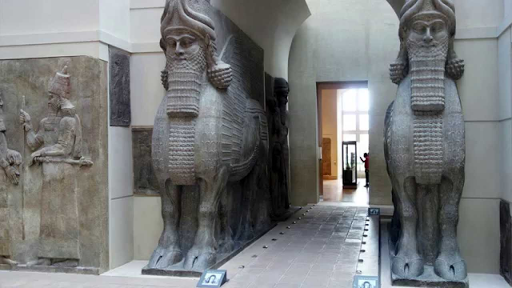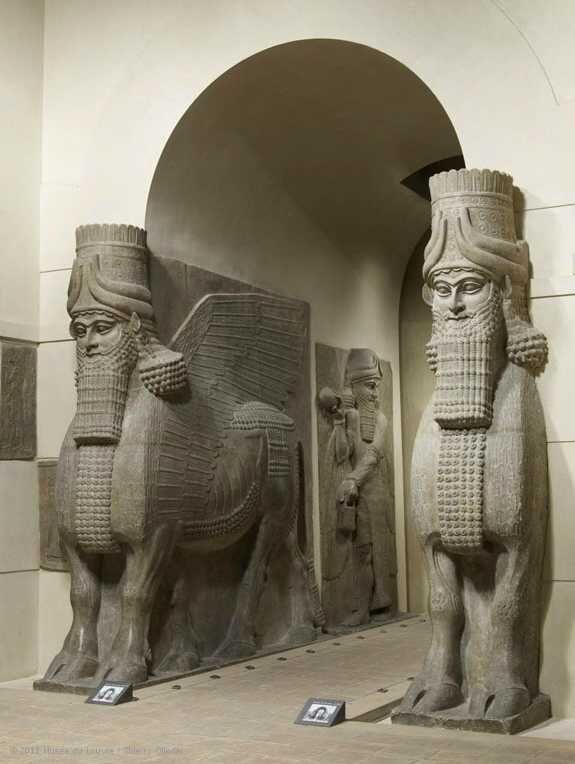Hermaphroditus was actually a popular subject of paintings and statuary even if Written By whitehouse March 11 2022 Add Comment Edit. What were the most common themes in Assyrian art.

Lamassu From The Citadel Of Sargon Ii Video Khan Academy
Lamassu were placed on either side of the doorways of Assyrian palaces and of gateways to cities to protect against evil spirits and impress the neighbors.

. The most famous colossal statues of Lamassu have been excavated at the sites of the Assyrian capitals established by King Assurnasirpal II reigned 883 859 BCE and King Sargon II reigned 721 705 BCE. These sculptures were excavated by P-E. In some cases the lamassu statues were accompanied by.
What ethnic group is credited with the first system of writing known to man. Furthermore where were the lamassu sculptures originally displayed. The lamassu in museums today including the Louvre shown in our video as well the British Museum The Metropolitan Museum of Art and National Museum of Iraq in Baghdad and others came from various ancient Assyrian sites located in modern-day Iraq.
Lamassu the were. In addition many of the sculptures were originally supposed to be displayed in the Ritz Carlton but never made it there because Mr. Botta 1843-44 Musée du Louvre Speakers.
From what we can tell it seems that these sculptures were believed to protect the palace and king from evil supernatural forces as well. 721-705 BCE Part of a collection at the Louvre in Paris France. The Assyrians envisioned a protective spirit that was part bull and part human and sometimes part eagle.
A Sargons palace b Gudeas Lagash c Ashurbanipals palace d Ziggurat at Ur Which of the following played an important role in the shaping of modern art. The lamassu of Ashurnasirpals Northwest palace were enormous stone-carved sculptures with the head of a human and displayed animal-like features including the wings of a bird and the body of a bull. Other lamassu survive on display in New York Paris London Chicago and Baghdad but now only Nimrud and Susa retain lamassu at their original locations.
Lamassu winged human-headed bulls possibly lamassu or shedu from the citadel of Sargon II Dur Sharrukin now Khorsabad Iraq Neo-Assyrian c. The first change was the capital was moved to Dur Sharrukin present day Khorsabad and second the Lamassu was presented on a bulls body compared to a lions and seems to be slightly smiling. What ethnic group is credited with the first system of writing known to man.
It is a Neo. Lamassu a huge sculpture that makes you feel tiny compared to it. However it is displayed in a museum in its original context a lamassu is the guardian of a doorway integral with a wall.
Originally unearthed in Rome and displayed in the Borghese Gallery it was sold to the occupying French and now sits in the Louvre. Which work has a king approaching the god Shamash. What color is lapis lazuli.
The Ziggurat at Ur was a fortress funerary monument palace temple platform Where were the Lamassu sculptures originally displayed. The Lamassu sculptures were recovered from where. 720-705 BCE gypseous alabaster 420 x 436 x 097 m excavated by P-E.
They were represented as double-aspect figures on corners in high relief. This was possibly the first time when Europeans watched the mythical monsters. Recent reports indicate that the.
The Lamassu sculptures were recovered from where. Much the best-known works are the huge lamassu guarding. In the Assyrian mythology there were human headed winged bullslions that were protective genies.
Backstory The lamassu in museums today including the Louvre shown in our video as well the British Museum The Metropolitan Museum of Art and National Museum of Iraq in Baghdad and others came from various ancient Assyrian sites located in modern-day Iraq. Ringling sent Julius Boger to Italy to pick and choose those sculptures to be displayed in Mr. Where were the lamassu sculptures originally displayed.
Assyrian sculpture typically placed prominent pairs of lamassu at entrances in palaces facing the street and also internal courtyards. It forms a phase of the art of Mesopotamia differing in particular because of its much greater use of stone and gypsum alabaster for large sculpture. Irreplaceable Lamassu sculpture Assyrian architecture and.
Steven Zucker IN THE NEWS. Assyrian sculpture is the sculpture of the ancient Assyrian states especially the Neo-Assyrian Empire of 911 to 612 BC which ruled modern Iraq Syria and parts of Iran. You can see them at Gate of All Nations at Persepolis in Iran the British Museum in London the Louvre in Paris the National Museum of Iraq in Baghdad the Metropolitan Museum of Art in New York and the University of Chicago Oriental Institute.
The Lamassu seen from the side from the palace Sargon II r. Click to see full answer. Where were the Lamassu sculptures originally displayed.
Currently representations of Lamassu are parts of collections at the British Museum in London Metropolitan Museum of Art in New York and The Oriental Institute in Chicago. For this reason it is not an entirely freestanding sculpture. These massive sculptures served as symbolic guards of Assyrian kings domain being placed at the entrance to both the city and palace gateways See Collins 2008 72.
Beth Harris and Dr. Which work has a king approaching the god. Strengthening these bonds further were the so-called Panhellenic sanctuaries and festivals that embraced all Greeks and encouraged interaction competition and exchange for example the Olympics which were held at the Panhellenic.
The palace stood pairs of powerful mythological creatures known as lamassu Gates 170-171. Ashurnasirpal Essay 1619 Words 7 Pages.
Colossal Lamassu Sculpture From The Palace Of Sargon Ii At Khorsabad Sargon Ii Google Arts Culture

25 Lamassu From The Citadel Of Sargon Ii Dur Sharrukin Modern Iraq Ap Art History

Lamassu Symbol For Protection Indrosphere

Lamassu Backstory Article Assyrian Khan Academy

Lamassus At The Louvre Thatmuse

Lamassu History 2701 Wiki Fandom
Human Headed Winged Lion Lamassu Assyrian Neo Assyrian The Metropolitan Museum Of Art
Early Excavations In Assyria Essay The Metropolitan Museum Of Art Heilbrunn Timeline Of Art History
0 comments
Post a Comment